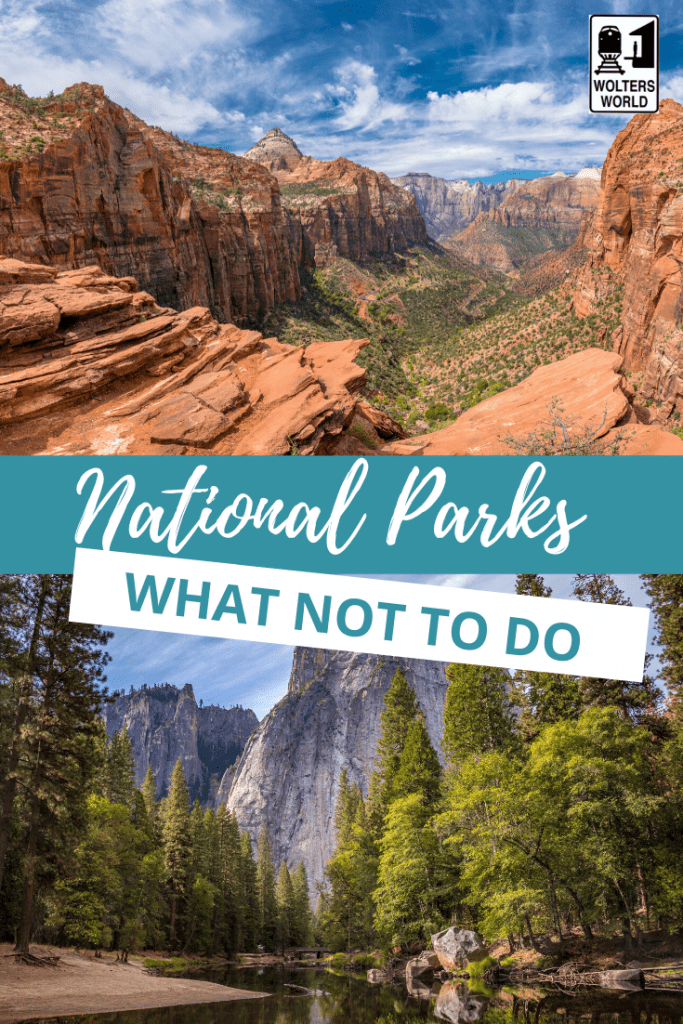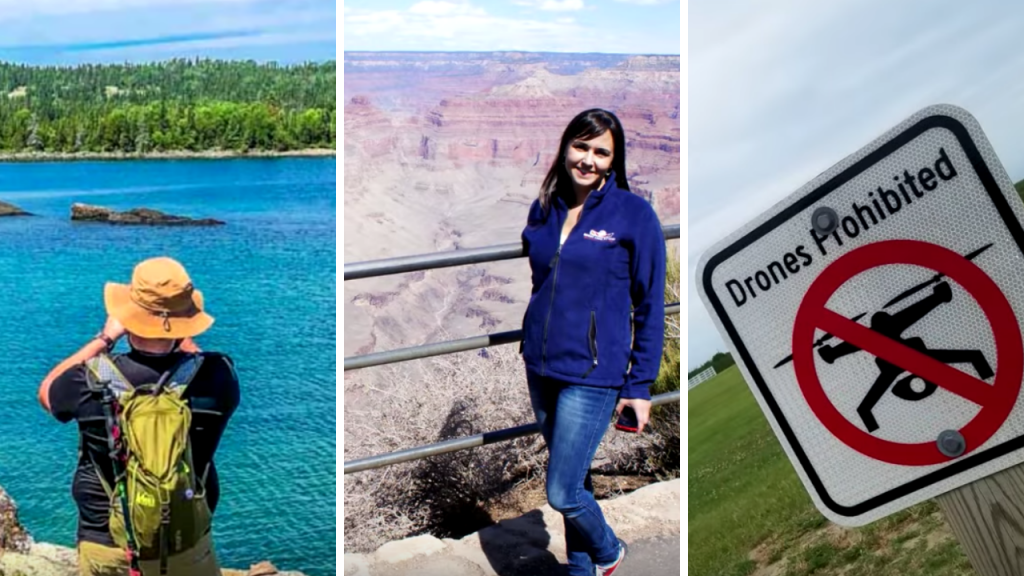Hey there, fellow travelers! Today, we’re talking about what NOT to do when you visit any of the National Park Service sites in the USA. While many travel blogs will tell you the best things to do in the National Parks and Monuments, we want to be sure you know about the things you should NOT do when you visit a National Park!
Don’t Be Disrespectful
Treat the National Park and National Monuments with care and conservation. This includes obvious things like not littering or not adding graffiti. But it also includes less obvious things like staying on the trails. Stepping off-trail might not seem like a big deal, but if everyone does it, it can start to cause erosion. A lot of the National Park rules are for your own safety.
Don’t Mess with the Animals
At least once a year, we hear about tourists having an unpleasant encounter with buffalo or elk at places like Yellowstone National Park. Even the cutest little chipmunks can carry diseases and they will bite you. Don’t feed animals in the national parks, and follow all park rules for maintaining an appropriate distance.

Don’t Forget a First Aid Kit
We always have a small First Aid kit on hand when we’re out traveling. It doesn’t have to be anything major. Ours is a small Ziploc bag with some Neosporin, bandages, sunscreen and bug spray. If you’re in the desert, tweezers are great for removing cactus spines.
The Most Common Travel Illnesses and Injuries
Don’t Forget Sun Protection
Sunscreen is a must for nearly any travel destination. Besides putting sunscreen on, you can also protect your skin with a hat and long sleeves that cover your arms. There are lots of hiking clothes now that are lightweight to keep you cool, but they protect your skin. Some even block UV rays. Nearly every NPS site has a National Park Service store that sells hats and hiking supplies, as well as some cool souvenirs to take home.
Don’t Get Dehydrated
Make sure you are drinking lots of water when you are touring the National Parks. Many are in a dry climate or higher elevation and you’ll need a lot of water to stay hydrated. The best way to do this is to carry a refillable water bottle everywhere you go. This helps reduce the plastic going into our landfills, but also saves you money as you’re not buying bottled water everywhere you go. Most National Park sites have bottle filling stations at the visitor center.
Don’t Count on Cell Phone Service
Depending on your provider and what National Park you are in, you may not have cell phone service. Many National Park visitor centers will have WiFi, but once you set off for a hike, you will quickly lose your signal. This even applies while driving; just because you’re on a paved road does not mean you will have cell service. That’s why a paper map or road atlas is one of our road trip essentials.
Don’t Forget About Junior Ranger Programs
If you are visiting National Parks with kids, make sure you check out the Junior Ranger program. It’s a fun way to get the kids excited about visiting the national parks and monuments. With the junior ranger program, it’s easy to make learning fun!

Don’t Miss Out on Other Programs for All Ages
The National Park sites have programs for all ages. Whether it’s guided hikes, interpretive reenactments or stargazing programs, there’s always something going on at the National Parks.
Don’t Forget Your National Parks Passport
You can buy a passport at any of the National Park stores and then get stamps at every site you visit. This is especially fun for kids, but adults can collect the stamps, too. With over 400 National Park sites in the US, that’s a lot of stamps you can collect!
Don’t Forget to Dress in Layers
If you’re going to be hiking in National Parks, it’s important to dress in layers. Mornings usually start off pretty cool, but the sun can get hot very quickly. Layers are great as you can easily add and remove them when you get too hot or too cold. It’s always a good practice to have warm clothes just in case you end up not getting back before dark.
Don’t Bring Your Drones
Drones are prohibited at National Parks and National Park sites. Drones can be very annoying to other visitors who are out to enjoy nature and they can disturb wildlife as well.
National Park Camping Tips from Grant and Bonnie of Our Wanderfilled Life
Grant and Bonnie are high school teachers who spend most of their vacation time touring the Nationals Parks and camping in their RV. We asked them for some of their “don’ts” for visiting National Parks.
Don’t Forget About all the National Park Sites
There are currently 61 designated National Parks. However, there are over 400 sites managed by the National Park Service. These include National Monuments, National Lakeshores, National Historical Parks, National Military Parks, and National Battlefields.
Don’t Forget to Make Reservations
If you are planning to stay overnight in the national parks, you must have reservations well in advance. There are a few park campgrounds that are first-come, first-served, but a lot of campgrounds and lodging choices book up months in advance, especially in high season. Even some tours or trails require advance reservations or permits.
Don’t Expect a Lot of Amenities at National Park Campgrounds
Campgrounds at most National Parks are quite sparse. They will usually have bathrooms, but sometimes that’s just a vault toilet. Most campgrounds do not have the luxurious hot showers and running water you would expect at a state park or a private campground.
Don’t Forget to Check the Food Storage Requirements
Food storage requirements vary by location. If you are in an area with bears, requirements will be very strict, especially if you’re in an area with grizzly bears. Some areas do not even allow soft-shell campers as bears can get inside for food. If a campsite provides a bear box for your food, make sure you put everything in there, including scented non-food items like toothpaste or deodorant.
Don’t Ignore Warning Signs
Warning signs are there for a reason, so don’t ignore them. Some of the warning signs may be over the top, but there’s usually an incident that prompted the sign. We’ve all heard about the tourists at Yellowstone who don’t stay on the boardwalk and fall into a boiling geyser. If there’s a warning sign, heed the warning, even if it seems silly. They are there to keep you safe!

Don’t Skip the Visitor Center
Chances are, you’re excited to get to a national park and see the big sites. But don’t pass right by the Visitor Center. This should be your first stop at the park. Besides paying your entry fee, you can learn a lot about the park at the visitor center. You can get a park map and also talk to the rangers about trail conditions, road conditions, or just to answer any questions you might have.
Don’t Gripe About the Fees
Yes, the National Parks are taxpayer-funded, and a lot of people take issue with paying entrance fees to access public lands. The National Parks are woefully underfunded, and the small sliver of your tax dollars that go to the NPS does not even cover the cost of your visit to one park. If you’re going to visit a lot of National Parks, the annual pass is a great deal. Senior Citizens can get a lifetime pass for the bargain price of $80. If you have a child in 4th Grade, your whole family can get in free for the duration of the school year.
Don’t Stay in Your Car
The National Parks have a lot of beautiful scenic drives and you can see a lot from your car. But once you get out of your car and start hiking, you’ll see so much more. The majority of National Parks visitors do not get out of their cars or do not go beyond the scenic viewpoints. If the park feels crowded to you, all you have to do is hike a couple of miles in and you’ll feel like you have the park to yourself.
Thanks to our friends Bonnie and Grant from Our Wanderfilled Life for their National Park camping tips! With over 400 National Park sites to choose from, we hope you’ll get out and explore some of these special places. Just remember what NOT to do on a visit to a National Park! Looking for more tips on travel in the USA? Check out these blog posts!
